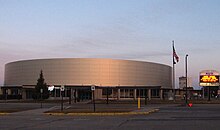Utica Memorial Auditorium
| The Aud | |
 |
|
| Location | 400 Oriskany Street West Utica, New York, USA 13502 |
|---|---|
| Owner | Upper Mohawk Valley Memorial Auditorium Authority |
| Operator | Upper Mohawk Valley Memorial Auditorium Authority |
| Capacity | 5,700 (floor events) 4,500 (basketball) 3,860 (hockey) |
| Construction | |
| Broke ground | April 15, 1957 |
| Opened | March 13, 1960 |
| Construction cost | $4.5 million ($36.4 million in 2017 dollars) |
| Architect | Gehron & Seltzer and Frank Delle Cese |
| Structural engineer | Lev Zetlin & Associates |
| Tenants | |
|
Utica Comets (AHL) (2013-present) Utica College Pioneers (NCAA) (2000-present) Utica Devils (AHL) (1987-1993) Utica Bulldogs (UHL) (1993-1994) Utica Blizzard (UHL) (1993-1997) Mohawk Valley Prowlers (UHL) (1997-2002) |
|
The Utica Memorial Auditorium is a 3,860-seat multi-purpose arena in Utica, New York, with a capacity of 5,700 for concerts. Nicknamed the Aud, it is the home arena of the Utica Comets, the AHL affiliate of the NHL's Vancouver Canucks.
The Utica Memorial Auditorium was conceived by then-Utica mayor John T. McKennan, who believed that the city needed a place for entertainment and sporting events. McKennan and the administration that he hired to plan out the process, led by Frank M. Romano, than hired Gilbert Seltzer, a well known architect at that time, to draw up plans for the building. A site was found along the old Erie Canal, and groundbreaking took place April 15, 1957. The arena was constructed using the world’s first pre-stressed dual cable roof system, designed by Lev Zetlin (who would later partner with architect Philip Johnson to construct both the New York State Pavilion "Tent of Tomorrow" seen at the 1964 World’s Fair and the Munson-Williams-Proctor Arts Institute, also located in Utica, NY) with "struts" between the cables. John A. Roebling’s Sons Company developed the tensioning method for the project. Zetlin's design became the predecessor to the many modern dome designs seen today, and has since influenced many other tensile structures including Madison Square Garden. Seltzer would take the most pride in constructing "The Aud", saying, “This was the first successful use of cables for a roof structure.”
"The Aud" was also one of the first stadiums to have telescopic seats. Telescopic bleachers (the bleachers pulled out from below higher levels) were common in stadiums, but Zetlin requested more comfortable seating for the arena.
Work continued through 1958 and into 1959. When the Auditorium was finally completed, it became one of just three arenas built without obstructed views. The arena opened on March 13, 1960, with the Greater Utica Industrial Exposition its first event, running three evenings from March 16–19. 96 exhibitors took part in the presentation which drew an attendance of some 45,000. In 1962, it hosted the NCAA Division I Men's Hockey Championship (AKA the "Frozen Four"). (In 2017, the arena will host the Division III "Frozen Four".)
Scenes from the 1977 film Slap Shot starring Paul Newman were shot at the Auditorium. The original center-hung scoreboard, as seen in the movie, was unusual in that the game time was kept by a digital clock, while the penalty time was kept by analog clocks. This was eventually replaced by a center-hung scoreboard designed by Eversan, which includes a one-line messageboard. "The Aud" also has the distinction of being the location of one of the last scheduled Elvis Presley concerts. The concert was scheduled to be on Friday, August 19, 1977, three days after Presley's death on August 16.
...
Wikipedia
